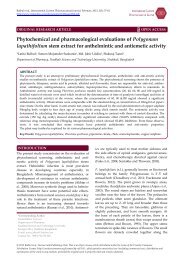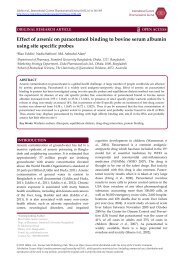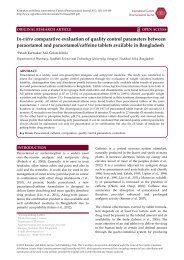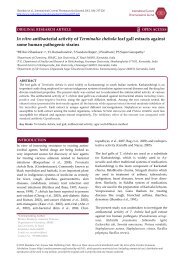Extraction of chitin from chitosan from exoskeleton of shrimp for ...
Extraction of chitin from chitosan from exoskeleton of shrimp for ...
Extraction of chitin from chitosan from exoskeleton of shrimp for ...
You also want an ePaper? Increase the reach of your titles
YUMPU automatically turns print PDFs into web optimized ePapers that Google loves.
Puvvada et al., International Current Pharmaceutical Journal 2012, 1(9): 258-263<br />
http://www.icpjonline.com/documents/Vol1Issue9/06.pdf<br />
<strong>Extraction</strong> <strong>of</strong> <strong>chitin</strong> <strong>from</strong> <strong>chitosan</strong> <strong>from</strong> <strong>exoskeleton</strong> <strong>of</strong> <strong>shrimp</strong> <strong>for</strong><br />
application in the pharmaceutical industry<br />
*Yateendra Shanmukha Puvvada 1 , Saikishore Vankayalapati 2 , Sudheshnababu Sukhavasi 3<br />
1 Bapatla College <strong>of</strong> Pharmacy, Bapatla, Andhra Pradesh, India<br />
2 Associate Pr<strong>of</strong>essor, Bapatla College <strong>of</strong> Pharmacy, Bapatla, Andhra Pradesh, India<br />
3 Bapatla College <strong>of</strong> Pharmacy, Bapatla, Andhra Pradesh, India<br />
INTRODUCTION<br />
Chitosan, a natural polysaccharide, is being widely<br />
used as a pharmaceutical excipients (Singla<br />
Struszczyk, 2002). It is obtained by the partial<br />
deacetylation <strong>of</strong> <strong>chitin</strong>, natural polymer composed<br />
<strong>of</strong> randomly distributed β-(1-4)-linked Dglucosamine.It<br />
consists <strong>of</strong> two types <strong>of</strong> monomers;<br />
<strong>chitin</strong>-monomers and <strong>chitosan</strong>monomers. Chitin is a<br />
linear polysaccharide consisting <strong>of</strong> (1-4)-linked 2acetamido-2-deoxy-b-D-glucopyranose.<br />
Chitosan is<br />
alinear polysaccharide consisting <strong>of</strong> (1-4)-linked 2amino-2-deoxy-b-D-glucopyranose<br />
(Tomihata and<br />
Ikada, 1997; Roberts, 1992).<br />
The amino group in <strong>chitosan</strong> has a pKa value <strong>of</strong><br />
~6.5, thus, <strong>chitosan</strong> is positively charged and soluble<br />
in acidic to neutral solution with a charge density<br />
dependent on pH and the percentage <strong>of</strong> degree <strong>of</strong><br />
International Current<br />
Pharmaceutical Journal<br />
ORIGINAL RESEARCH ARTICLE OPEN ACCESS<br />
ABSTRACT<br />
Chitosan is an amino polysaccharide prepared by processing <strong>shrimp</strong> waste (shell) which involves partial deacetylation<br />
<strong>of</strong> <strong>chitin</strong>. Chitosan, a versatile natural polysaccharide, the second most abundant natural polymer. Many<br />
biochemists have found that <strong>chitosan</strong> as biocompatible, biodegradable and non toxic which made wide applicability<br />
in conventional pharmaceutics as a potential <strong>for</strong>mulation excipient. In this research mainly the focused on the<br />
synthesis <strong>of</strong> <strong>chitosan</strong> which is suitable <strong>for</strong> the pharmaceutical industry especially in the designing delayed and<br />
controlled drug delivery systems. The main study focused on preparation low molecular weight <strong>of</strong> the <strong>chitosan</strong><br />
suitable <strong>for</strong> pharmaceutical industry. The crude <strong>chitin</strong> was collected <strong>from</strong> <strong>exoskeleton</strong> <strong>of</strong> Triopslongicaudatus and<br />
Triopscancri<strong>for</strong>mis specimens which are then processed to obtain <strong>chitosan</strong>. The <strong>chitosan</strong> yield was found to be 35.49%<br />
and it was analyzed <strong>for</strong> its physiochemical parameters.<br />
Key Words: Chitin, extraction, purification, characterisation, pharmaceutical grade <strong>chitosan</strong>.<br />
*Corresponding Author:<br />
Yateendra Shanmukha Puvvada<br />
Bapatla College <strong>of</strong> Pharmacy<br />
HNO 53 Vivekananda Colonny<br />
Ii Lane, Suryalanka Road, Bapatla 522101, India.<br />
E-mail: pr.shanmukhapuvvada@gmail.com<br />
Contact No.: +919963395220<br />
deacetylation- value. In other words, <strong>chitosan</strong> is<br />
bioadhesive and readily binds to negatively charged<br />
surfaces such as mucosal membranes. Chitosan<br />
enhance the transport <strong>of</strong> polar drugs across epithelial<br />
surfaces, and is biocompatible and biodegradable.<br />
Purified qualities <strong>of</strong> <strong>chitosan</strong>s are available <strong>for</strong><br />
biomedical application (Cho et al., 1998).<br />
Chitosan insipite <strong>of</strong> its unique properties is proving<br />
its efficacy in various dosage <strong>for</strong>ms such as bioadhesive<br />
nature, hydrophilic macromolecule drug<br />
carrier, effective carrier in drug targgetting to brain,<br />
transdermal films and wound healing biodegradable<br />
grafts, hyperlipidemic , antimicrobial and<br />
stabilizing constituent <strong>of</strong> liposomes. Chitosan <strong>for</strong> its<br />
pontential makes it as a promising candidate as<br />
pharmaceutical excipient (Muzzrelli et al., 1996; Lehr<br />
et al., 1992).<br />
The presence <strong>of</strong> a number <strong>of</strong> amino groups permit<br />
<strong>chitosan</strong> to chemically react with anionic systems,<br />
thereby resulting in alteration <strong>of</strong> physicochemical<br />
characteristics <strong>of</strong> such combinationssome <strong>of</strong> which<br />
include binding, disintegrating and tablet coating<br />
© 2012 Puvvada et al.; licensee Saki Publishing Club. This is an Open Access article distributed under the terms <strong>of</strong> the Creative Commons<br />
Attribution License (http://creativecommons.org/licenses/by-nd/3.0/), which permits unrestricted use (including commercial use), distribution and<br />
reproduction <strong>of</strong> the work in any medium, provided the original work is properly cited and remain unaltered.
properties (Frizakepsutlu et al., 1999). The polymer<br />
in another <strong>for</strong>m i.e available as d-glucosamine<br />
commercially with the slightest chemical modification<br />
has also been investigated as a potential<br />
treatment <strong>for</strong> arthritis. Chitosan alone is biologically<br />
active which is efficient in managing dietary<br />
treatments and also exhibit pharmacology as<br />
antimicrobial, hypocholesterolemic and would<br />
healing. Its unique structure makes opens its<br />
applicability as promising candidate not only as<br />
pharmaceutical aid but also in specific drug targeting<br />
and delivery. This research mainly focuses on<br />
the synthesis<strong>of</strong> pharmaceutical grade <strong>chitosan</strong><br />
confining to predetermined quality attributes <strong>of</strong> its<br />
physiochemical properties such as gram molecular<br />
weight, viscosity, the extent <strong>of</strong> deacetylaltion,<br />
reminisces after burnt, water log content, present <strong>of</strong><br />
heavymetals etc.<br />
MATERIALS AND METHODS<br />
Sample preparation<br />
The <strong>shrimp</strong>s were obtained <strong>from</strong> Penaeuscarinatus<br />
and Penaeusmonodon specimens collected <strong>from</strong><br />
Suryalanka coast (Lat.15.83454°NLong. 80.50507°E)<br />
and the shell and operculum are removed <strong>from</strong> the<br />
animal. The <strong>shrimp</strong>s <strong>exoskeleton</strong>s collected are<br />
placed in Ziploc bags and refrigerated overnight<br />
Approximately1500 grams <strong>of</strong> crushed <strong>shrimp</strong>’s<br />
<strong>exoskeleton</strong>s wet samples were placed on foil paper<br />
and measured using a balance. The <strong>shrimp</strong> <strong>exoskeleton</strong>s<br />
were crushed into smaller pieces using a meat<br />
tenderizer. The samples were oven-dried <strong>for</strong> 4<br />
consecutive days at 65°C until constant weight. The<br />
dry weights <strong>of</strong> the samples were determined to be<br />
1269 grams. The obtained <strong>shrimp</strong> is made into 4<br />
equal parts <strong>for</strong> efficient material handling (Toan,<br />
2009).<br />
<strong>Extraction</strong> <strong>of</strong> <strong>chitin</strong> and <strong>chitosan</strong><br />
The <strong>chitin</strong> and <strong>chitosan</strong> sequence involves washing<br />
<strong>of</strong> crushed <strong>exoskeleton</strong>s. crushed <strong>shrimp</strong>s <strong>exoskeleton</strong>s<br />
were placed in 1000 ml beakers and soaked in<br />
boiling sodium hydroxide (2 and 4% w/v) <strong>for</strong> one<br />
hour in order to dissolve the proteins and sugars<br />
thus isolating the crude <strong>chitin</strong>. 4% NaOH is used <strong>for</strong><br />
<strong>chitin</strong> preparation, concentration used by the<br />
scientists at the Sonat Corporation (Lertsutthiwong<br />
et al., 2002). After the samples are boiled in the<br />
sodium hydroxide, the beakers containing the<br />
<strong>shrimp</strong> shell samples are removed <strong>from</strong> the hot<br />
plate, and allowed to cool <strong>for</strong> 30 minutes at room<br />
temperature (Lamarque et al.,2005). The <strong>exoskeleton</strong>s<br />
are then further crushed to pieces <strong>of</strong> 0.5-5.0 mm<br />
using a meat tenderizer.<br />
Demineralization<br />
The grounded <strong>exoskeleton</strong> is demineralizedusing<br />
1% HCl with four times its quantity. The samples<br />
were allowed to soak <strong>for</strong> 24 h to remove the minerals<br />
(mainly calcium carbonate) (Trung et al., 2006).<br />
The demineralized <strong>shrimp</strong> shell samples were then<br />
treated <strong>for</strong> one hour with 50 ml <strong>of</strong> a 2% NaOH<br />
solution to decompose the albumen into water<br />
soluble amino-acids. The remaining <strong>chitin</strong> is washed<br />
with deionized water, which is then drained <strong>of</strong>f. The<br />
<strong>chitin</strong> was further converted into <strong>chitosan</strong> by the<br />
process <strong>of</strong> deacetylation (Huang et al., 2004).<br />
Deacetylation<br />
The deacetylation process is carried out by adding<br />
50% NaOH and then boiled at 100°C <strong>for</strong> 2 h on a hot<br />
plate. The samples are then placed under the hood<br />
and cooled <strong>for</strong> 30 min at room temperature. Afterwards<br />
the samples are washed continuously with<br />
the 50% NaOH and filtered in order to retain the<br />
solid matter, which is the <strong>chitosan</strong>. The samples<br />
were then left uncovered and oven dried at 110°C<br />
<strong>for</strong> 6 h. The <strong>chitosan</strong> obtained will be in a creamywhite<br />
<strong>for</strong>m (Muzzarelli and Rochetti, 1985).<br />
Purification <strong>of</strong> Chitosan<br />
The obtained <strong>chitosan</strong> has to be purified to make it<br />
suitable <strong>for</strong> the pharmaceutical use. The purification<br />
process was designed in three steps<br />
1) Removal <strong>of</strong> insolubles with filteration<br />
2) Reprecipitation <strong>of</strong> chitiosan with 1 N NaOH<br />
3) Demetallisation <strong>of</strong> retrieved <strong>chitosan</strong><br />
Removal <strong>of</strong> insolubles with filtration<br />
1 mg/ml <strong>chitosan</strong> acetic acid 1% (v/v) solution is<br />
prepared by a magnetic stirrer until an homogenous<br />
solution is obtained. The insolubles were removed<br />
by filteration through Whatman filter paper 22µm.<br />
Reprecipitation <strong>of</strong> <strong>chitosan</strong> with 1N NaOH<br />
Chitosan was precipitated <strong>from</strong> filtered <strong>chitosan</strong><br />
solution by titration with 1 N NaOH until pH value<br />
<strong>of</strong> 8.5. The <strong>chitosan</strong> obtained is washed several<br />
times with distilled water by centrifuging at 8,000 to<br />
259
Table 1: Characteristics <strong>of</strong> <strong>chitosan</strong> obtained <strong>from</strong> the<br />
panaeusmonodon.<br />
Characteristics Chitosan<br />
Chitosan yield 34%<br />
Average molecular weight 1,599,558.029<br />
Degree <strong>of</strong> deacetylation 89.79%<br />
Viscosity 304cps<br />
pH 8.5<br />
Ash value 0.25%<br />
Loss on drying 9.34%<br />
Heavy metals >10ppm<br />
RESULTS AND DISCUSSION<br />
The synthesis <strong>of</strong> <strong>chitosan</strong> involves various chemical<br />
steps such as preparation <strong>of</strong> the <strong>chitin</strong> <strong>from</strong> the<br />
crude shells which will be the initiation <strong>of</strong> the<strong>chitosan</strong><br />
synthesis with the removal <strong>of</strong> the proteins in the<br />
shells followed by demineralization <strong>for</strong> the removal<br />
<strong>of</strong> the carbon and other salts present in the crude<br />
<strong>for</strong>m which will be preceded by the deacetylation <strong>of</strong><br />
the <strong>chitin</strong> that would result in <strong>chitosan</strong>. The regular<br />
<strong>chitosan</strong> is obtained by following the above steps,<br />
but a polymer <strong>of</strong> pharmaceutical grade has to fall in<br />
the region <strong>of</strong> its predetermined quality aspects and<br />
Usually commercial <strong>chitin</strong>s are prepared by a first<br />
step <strong>of</strong> deproteinisation followed by a second step<br />
<strong>of</strong> demineralization. The whole parameters were<br />
tabulated in the table1 and their respective characteristics<br />
are discussed. The <strong>chitosan</strong> yield was found<br />
to be 34% after purification <strong>of</strong> the total <strong>exoskeleton</strong><br />
taken. In these conditions the native structure <strong>of</strong> the<br />
<strong>chitin</strong> is lost, is extracted. On the otherhand, “in<br />
which the native chain and fibrous structures are<br />
intact and stabilized, is extracted when demineralization<br />
occurred in the first step.<br />
Early studies have clearly demonstrated that<br />
specific characteristics <strong>of</strong> these products (Mw, DD)<br />
depend on the process conditions. Taking these two<br />
facts into account, the reaction conditions must be<br />
controlled when preparing <strong>chitosan</strong>. The <strong>chitosan</strong><br />
obtained <strong>from</strong> the above process was reported to<br />
have average molecular weight <strong>of</strong> 1,599,558.029<br />
which literally conclude that majority <strong>of</strong> the linkage<br />
was intact instead <strong>of</strong> splitting up by the influence <strong>of</strong><br />
the strong alkali. The purification procedure<br />
included removing insoluble contaminations and<br />
adding deproteinization and demetallization agents,<br />
SDS and EDTA, respectively, in the presence <strong>of</strong> the<br />
Table 2: Wave length <strong>of</strong> the main bands obtained <strong>for</strong> the<br />
standard <strong>chitosan</strong> and <strong>chitosan</strong> extracted <strong>from</strong> N.<br />
crepidularia.<br />
Vibration modes Standard Penaeusmonodon<br />
NH out – <strong>of</strong> – plane bending 752 752<br />
Ring stretching 896 893<br />
CO stretching 1026 1022<br />
CH2 bending and CH3 de<strong>for</strong>mation 1418 1421<br />
Amide II band 1563 1552<br />
Amide I band 1661 1643<br />
CH stretching 2878 2865<br />
Symmetric CH3 stretching and 2930 2921<br />
asymmetric CH2 stretching<br />
NH stretching 3268 3283<br />
reducing agent, DTT. This resulted in the <strong>for</strong>mation<br />
<strong>of</strong> water insoluble <strong>chitosan</strong> precipitates or flocculants,<br />
and water soluble supernatants that included<br />
the deproteinization agent and any proteins that<br />
havecomplexed with it and the demetallization<br />
agent with the extracted metals. Adding the reducing<br />
agent enhanced the water solubilization <strong>of</strong><br />
protein impurities by dissociating any disulfide<br />
bonds present in the proteins. The demetallization<br />
agent was mixed with the <strong>chitosan</strong> solutions under<br />
basic pH conditions to avoid the <strong>for</strong>mation <strong>of</strong><br />
<strong>chitosan</strong>-metalchelate conjugates. The degree <strong>of</strong><br />
deacetylation (DD) <strong>of</strong> <strong>chitosan</strong> plays a significant<br />
role <strong>for</strong> determining the specific applications <strong>of</strong><br />
<strong>chitosan</strong>.<br />
Degree <strong>of</strong> deacetylation <strong>of</strong> the compound is 89.79%<br />
However, these higher DD values are the consequence<br />
<strong>of</strong> the high amount <strong>of</strong> protein, yielding high<br />
quality <strong>of</strong> <strong>chitosan</strong> suitable <strong>for</strong> the pharmaceutical<br />
application. Degree <strong>of</strong> deacetylation affects thechemical,<br />
physical and biological properties <strong>of</strong><br />
<strong>chitosan</strong>, such as adsorption, covalent linking,<br />
encapsulation. The viscosity <strong>of</strong> the pharmaceutical<br />
<strong>chitosan</strong> is very important aspect in handling as<br />
polymer <strong>for</strong> the drug delivery. The viscosity pr<strong>of</strong>ile<br />
304 cps <strong>of</strong> the <strong>chitosan</strong> prepared shows that it<br />
would fall under the region <strong>of</strong> most pharmaceutical<br />
products do which are suitable <strong>for</strong> designing drug<br />
delivery systems..The Prolonged decalcification<br />
time, even during 24 h, results in a very slight drop<br />
in the ash content but can cause polymer degradationthe<br />
calicium carbonate which demonstrates as<br />
ash value is very low. The FT-IR studies <strong>of</strong> the<br />
<strong>chitosan</strong> <strong>from</strong> standard commercial species. The<br />
261
Figure 1: The FT-IR report <strong>of</strong> the standard <strong>chitosan</strong>.<br />
major absorption band is observed between 1220<br />
and 1020 cm -1 which represents the free amino<br />
group (-NH2) at C2 position <strong>of</strong> glucosamine, a major<br />
group present in <strong>chitosan</strong>. Further the sample<br />
showed the absorption bands <strong>for</strong> the free amino<br />
group between 1026 and 1259 cm -1 when the peak at<br />
1374 cm -1 represents the –C-O stretching <strong>of</strong> primary<br />
alcoholic group (-CH2 - OH). The absorbance bands<br />
<strong>of</strong> 3268, 2930,2878,1563, and 1418 cm -1 indicated the<br />
N-H stretching, Symmetric CH3 stretching and<br />
asymmetric CH2 stretching, CH stretching,C=O<br />
stretching in secondary amide (amide I) and C–N–<br />
stretching in secondary amide (amide II), respectively.<br />
In the present study also the same absorbance<br />
bands were observed at 3283, 2921,<br />
2865,1643,1552,1421, 1022, 893and 752 cm -1 which<br />
confirms the structure <strong>of</strong> <strong>chitosan</strong> <strong>from</strong> table 2 and<br />
figure 1 and 2.<br />
CONCLUSION<br />
Pharmaceutical industry is in need <strong>of</strong> different types<br />
<strong>of</strong> <strong>chitosan</strong> presently available in the market which<br />
are to be refined further more to meet the required<br />
standards. For instance Chitosan used in the wound<br />
healing and scaffolds must be in the <strong>for</strong>m <strong>of</strong><br />
oligomeres having low molecular weight in <strong>for</strong>mer<br />
case where as later ones need more proliferated<br />
structure and high molecular weight <strong>for</strong> tissue<br />
engineering. Drug delivery systems such as floating,<br />
intestinal, and other gel <strong>for</strong>ms require high molecular<br />
weight with high degree <strong>of</strong> deacetylation.<br />
Simultaneously vaccine, gene, and enzyme drug<br />
delivery systems are suitable in high molecular<br />
weight <strong>chitosan</strong>s which are highly deacetylated<br />
(>85% ), different techniques are employed <strong>for</strong> these<br />
Figure 2: The FT-IR report <strong>of</strong> the <strong>chitosan</strong> extracted <strong>from</strong><br />
the penaeusmonodon.<br />
type <strong>of</strong> drug delivery systems such as adsorption,<br />
covalent linking, encapsulation, which require<br />
dense network , potentially charged ends and long<br />
chains respectively. Chitosan is used in design <strong>of</strong><br />
many different types <strong>of</strong> drug carriers <strong>for</strong> various<br />
administration routes like oral, parenteral, nasal,<br />
buccal, transdermal, vaginal, topical etc. It can be<br />
<strong>for</strong>mulated as nanoparticles, microspheres, membrane<br />
sponge etc. For drug delivery, special<br />
preparation techniques are used to prepare <strong>chitosan</strong><br />
drug carriers by taking care such parameters as cross<br />
linker concentration, <strong>chitosan</strong> molecules weight and<br />
processing conditions all these effect release rate <strong>of</strong><br />
the loaded drug. Chitosan seems to be the biopolymer<br />
<strong>for</strong> the development <strong>of</strong> new derivatives such as<br />
Water-soluble derivatives <strong>of</strong> <strong>chitosan</strong> , Quaternarized<br />
derivatives, Caboxyalkylation, Chitosan Esters,<br />
sulfonated derivatives <strong>of</strong> <strong>chitosan</strong>, N-trimethylene<br />
chloride <strong>chitosan</strong>, Chitosan conjugates:<br />
ACKNOWLEDGEMENTS<br />
ACKNOWLEDGEMENT<br />
The authors would like to express thanks to the Mr.<br />
Everest Edward, Managing Director <strong>of</strong> India Sea<br />
Food, Chochin, Kerala <strong>for</strong> his generous support and<br />
valuable advices in carrying this research work.<br />
REFERENCES<br />
REFERENCES<br />
Cho, Y., No, H.K., and Meyers, S.P., (1998). Physicochemical<br />
characteristics' and functional properties <strong>of</strong> various commercial<br />
<strong>chitin</strong> and <strong>chitosan</strong> products. Journal <strong>of</strong><br />
Agriculture and Food Chemistry, 46(9), 3839-3843. [DOI]<br />
Frizakepsutlu, ayhansavaser, yalcinozkan, necatidikmen and<br />
askinisimer. (1999) Evaluation <strong>of</strong> <strong>chitosan</strong> used as excie-<br />
262
pient in tablet <strong>for</strong>mulation. Acta poloniae pharmaceuticadrug<br />
research, 56(3):227-235.<br />
Huang, M. et al. (2004) Uptake and cytotoxicity <strong>of</strong> <strong>chitosan</strong><br />
molecules and nanoparticles: Effects <strong>of</strong> molecular weight<br />
and degree <strong>of</strong> deacetylation. Pharmaceutical Research, 21<br />
(2), 344-353. [DOI]<br />
Lamarque, G. et al. (2005) Physicochemical behavior <strong>of</strong><br />
homogeneous series <strong>of</strong> acetylated <strong>chitosan</strong>s in aqueous<br />
solution: role <strong>of</strong> various structural parameters. Biomacromolecules,<br />
6 (1), 131-142. [DOI]<br />
Lehr CM, Bouwstra JA, Schacht EH, Junginger HE. (1992)<br />
Formulation and evaluation <strong>of</strong> mucoadhesiveglipizidemicrospheresInt.<br />
J. Pharm, 78, 43-48. [DOI]<br />
Lertsutthiwong, P., How, N.C., Chandrkrachan, S. and<br />
Stevens, W.F. (2002) Effect <strong>of</strong> chemical treatment on the<br />
characteristics <strong>of</strong> <strong>shrimp</strong> <strong>chitosan</strong>. Journal <strong>of</strong> metals,<br />
materials and minerals, 12(1): 11-18.<br />
Merlinaa ,delorino and salvacion p . (2009) cresidio Investigation<br />
<strong>of</strong> <strong>chitosan</strong> <strong>from</strong> squid pen as Scar Remover. World<br />
applied sciences journal 5 (special issue <strong>for</strong> environment)<br />
98-103.<br />
Mirzadeh, H., Yaghobi., N., Amanpour, S., Ahmadi, H.,<br />
Mohagheghi, M.A. and Hormozi, F. (2002) Preparation <strong>of</strong><br />
Chitosan Derived <strong>from</strong> Shrimp's Shell <strong>of</strong> Persian Gulf as a<br />
Blood Hemostasis Agent. Iranian Polymer Journal, 11(1):<br />
63-68.<br />
MonarulIslama Shah., Md. Masumb., M. MahbuburRahmana.,<br />
Md. Ashraful Islam Mollab. (2011) Preparation <strong>of</strong><br />
Chitosan <strong>from</strong> Shrimp Shell and Investigation<strong>of</strong> Its Properties.<br />
International Journal <strong>of</strong> Basic & Applied Sciences<br />
IJBAS-IJENS, 11(1), 116-130.<br />
Muzzarelli RAA, Rochetti R. (1985) Determination <strong>of</strong> the<br />
degree <strong>of</strong> deacetylation <strong>of</strong> <strong>chitosan</strong> by first derivative<br />
ultraviolet spectrophotometry. J CarbohydrPolym, 5, 461-<br />
72. [DOI]<br />
Muzzrelli, R.A.A., Terbojevich, M. and Cosani, A. (1996)<br />
Unspecific activities <strong>of</strong> lipases and amylases on <strong>chitosan</strong>s.<br />
In: Chitin Enzymology Vol. 2, R.A.A.Muzzarelli (ed), Atec,<br />
Grottammare, Italy, 69-82.<br />
Qian, R.Q. and Glanville, R.W. (2005) Methods <strong>for</strong> purifying<br />
<strong>chitosan</strong> Providence Health System.<br />
Roberts GAF (1992). Preparation <strong>of</strong> <strong>chitin</strong> and <strong>chitosan</strong>. The<br />
Macmillan UK: London Press.<br />
SinglaStruszczyk, M.H. (2002) Chitin and <strong>chitosan</strong> - Part II.<br />
Applications <strong>of</strong> <strong>chitosan</strong>. Polimery, 47 (6), 396-403<br />
Toan, N.V. (2009) Production <strong>of</strong> Chitin and Chitosan <strong>from</strong><br />
Partially Autolyzed Shrimp Shell Materials. The Open<br />
Biomaterials Journal, 1:21-24. [DOI]<br />
Tomihata, K. and Ikada, Y. (1997) In vitro and in vivo<br />
degradation <strong>of</strong> films <strong>of</strong> <strong>chitin</strong> and its deacetylated derivatives.<br />
Biomaterials, 18 (7), 567-575. [DOI]<br />
Trung TS, Thein-Han WW, Qui NT, Ng CH, Stevens WF.<br />
(2006) Functional characteristics <strong>of</strong> <strong>shrimp</strong> <strong>chitosan</strong> and its<br />
membranes as affected by the degree <strong>of</strong> deacetylation.<br />
BioresourTechnol, 97(4), 659-63. [DOI]<br />
Yong Hu.,Xiqun Jiang., Yin Ding., Haixiong Ge., Yuyan<br />
Yuan.,Changzheng Yang . (2002) Synthesis and characterization<br />
<strong>of</strong> <strong>chitosan</strong>–poly(acrylic acid) nanoparticles.<br />
Elsevier Science Ltd. Biomaterials, 23, 3193-3201. [DOI]<br />
Zhanga Y., Zhanga, X., Dinga, R., Zhanga, J. &Liub, J. (2011)<br />
Determination <strong>of</strong> the degree <strong>of</strong> deacetylation <strong>of</strong> <strong>chitosan</strong><br />
by potentiometric titration preceded by enzymatic pretreatment.<br />
Carbohydrate Polymers, Vol. 83, 813–817.<br />
263









